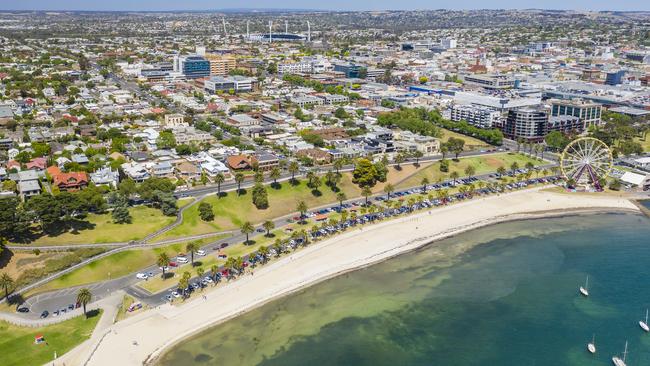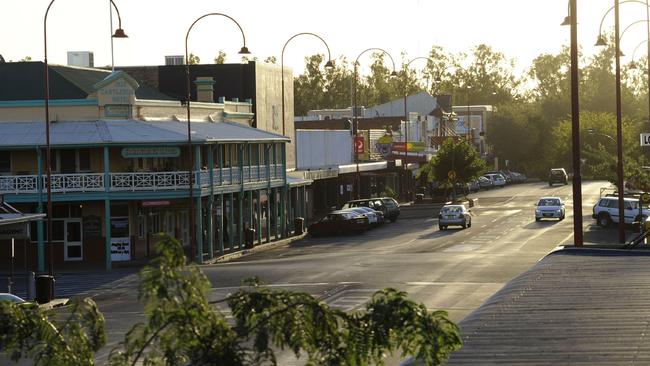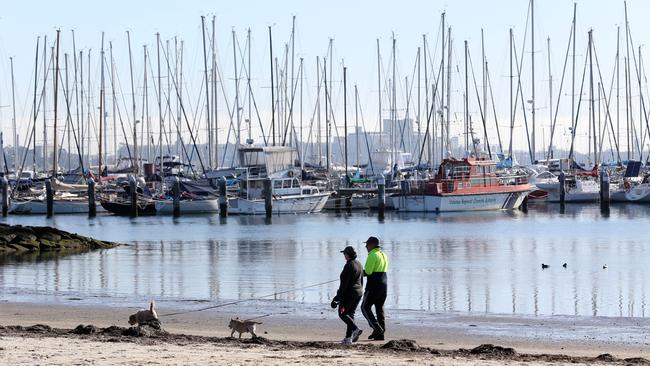The moment is here for our regional renaissance
There has never been a better time to grab a taxpayer dollar. Regionalisation is on a roll but needs greater national policy co-ordination.

The pandemic recession never made it into Dubbo, in the NSW central west. When border closures, shutdowns and social distancing measures unplugged capital cities and drove the national jobless rate to 7.5 per cent last July, unemployment plunged to 1.4 per cent in the bustling region of 54,000.
According to the National Skills Commission, the annual increase in job vacancies in the broader Dubbo and western NSW region was almost 90 per cent last month, the strongest growth of the nation’s 37 regions.
Megan Dixon, who runs the Orana office in Dubbo of the non-profit Regional Development Australia, says the place is humming. “We have work, so come out here,” Dixon tells Inquirer. “There is support available to people who make the move.”
Tourism is going “gangbusters”, according to the region’s mayor. Hotels are at 80 per cent occupancy and visitor numbers have doubled for popular attractions. Dixon says some local five-day businesses have become seven-day operations, home building has taken off and job vacancies soared.
Yet 18 months ago Dubbo was in the grip of dust and drought, facing an imminent “day zero” if it did not rain or emergency measures were not taken. Running out of water for the first time would have plunged communities, even resilient places with scale such as Dubbo, into a wretched economic and social spiral.
But rain came, filling dams. Then COVID-19 changed the tempo, for Dubbo and regional centres across the nation, as work from home took root, shutdowns choked the capitals, domestic tourism boomed, young people retreated to the family home for study and financial shelter, and Canberra irrigated a nation with borrowed money. People also voted with their feet as areas outside capital cities had their largest net population gains on record because of the forces unleashed by the pandemic and our coping mechanisms. The places beyond our suburbs are as diverse as our continent, but one thing appears to unite them. Regions, where one in three people live, are on a roll.

Boosters believe their moment has arrived. Next month Deputy Prime Minister Michael McCormack, who is also the Infrastructure, Transport and Regional Development Minister, will launch the Regional Australia Institute’s national awareness campaign to promote regional growth. On Tuesday, the National Farmers Federation is launching a regionalisation agenda at the National Press Club in Canberra, arguing a convergence of digital connectivity, modern manufacturing processes and political unanimity. What’s lacking is national policy co-ordination.
“This is a one in 100-year moment for regional Australia to make its case to governments and urban Australians alike, and articulate a vision for what our regions could become with the right encouragement,” NFF president Fiona Simson says.
COVID-19 has been an accelerant and retardant for social, economic and, as the quest for vaccines has proved, technological change. Some of those shifts may be blips in the data because of emergency responses; others will persist, challenging infrastructure planners and service providers. Certainly, the pandemic is an opportunity to give mature issues a nudge, not least because there has never been a better time to grab a taxpayer dollar, with near-zero borrowing rates and the policy class having experienced debt-conversion therapy.
Canberra’s spending footprint is one-third of national output; if you can’t get some of this action, fire your lobbyist. Pre-budget submissions rolling into Treasury are tinged with more hope than usual amid a rebalancing of national priorities and the gentle aroma of an early-harvest poll.
Australia has been dabbling in decentralisation since the 1960s. Gough Whitlam’s Albury-Wodonga shotgun marriage now looks like forlorn utopianism. More recently, moving federal agencies to towns and dropping dollops of development grants seem half-arsed at best, agrarian electioneering at worst. The Productivity Commission has called out this sub-optimal cash splash.
In the budget last October, McCormack announced a $110bn federal 10-year investment pipeline, with about $36bn directly going to regions. There was money for shovel-ready projects, local road programs and a new round of the Building Better Regions Fund. There’s no lack of dollars in regional reservoirs.
Pork-barrelling is business as usual, no matter the shade of government. Opposition infrastructure, transport and regional development spokeswoman Catherine King’s critique is the Morrison government lacks a plan to harness this abundant expenditure properly. She and Anthony Albanese speak of “smart regionalisation”, with investment guided by long-term population and economic trends to get maximum benefit for taxpayers. “There’s a scattergun of regional programs,” King says. “We need more strategic thinking and better co-ordination across portfolios and levels of government.”

People on the ground are frustrated that so much has been committed yet little has changed.
“Regionalisation has been an enduring policy for probably longer than 50 years, but in the last three decades it may have ‘stuttered’ for inland areas, particularly around population policy,” says RDA Orana’s Dixon, who has spent three decades in regional development.
“From a government perspective, pushing population into the regions supports the achievement of economic growth and takes tremendous pressure off the provision and refit of cities that’s been occurring around infrastructure.”
Infrastructure Australia’s chief of policy and research Peter Colacino points to five key trends he says will endure in the recovery: digitisation, localisation, decentralisation, service innovation and adaptability. Those forces will reinforce population shifts to small towns and regions, and will shape the way we plan for the future.
Colacino notes the mass take-up of telehealth services during the pandemic and rooftop solar as drivers of change on soft and hard infrastructure. The Morrison government has asked IA to drill into regional gaps and strengths with a view to changing the way its key infrastructure adviser determines the nation’s investment roadmap. “It will lead to a more bottom-up approach to informing our decisions,” Colacino says ahead of the release on Friday of IA’s updated Infrastructure Priorities List of nationally significant projects.
Aude Bernard, from the University of Queensland’s Queensland Centre for Population Research, says in recent decades Australians have become less prepared to move interstate, even though we are among the most mobile people in the developed world with 40 per cent of us changing address every five years. COVID-19 has exacerbated the fall in interstate migration because of border closures and economic anxiety.
But a new collection by the Australian Bureau of Statistics, Provisional Regional Internal Migration Estimates, shows a strong population shift from capital cities to regions during the pandemic.
In the June quarter last year, the net gain to regions was 11,000, followed by 11,200 in September. These are double 10-year average quarterly gains. In its analysis, the Centre for Population, located in Treasury, noted that in the year to September areas outside capital cities had a net gain of 36,200 people, the highest on record.
According to Elin Charles-Edwards, a UQ population geographer, the main driver of the shift is people are staying put in the regions because of COVID-19 restrictions and a deteriorating job outlook in cities, particularly Melbourne under lockdowns. A recent paper by UQ researchers on internal migration noted flows between capital cities and regions respond to changes in labour and housing market conditions. A 10 per cent increase in the unemployment rate in capital cities relative to regional areas will boost migration to regional areas by 3.6 per cent, while a 10 per cent increase in house prices in regional areas relative to capital cities will decrease migration from capital cities to regional areas by 14.6 per cent. The pandemic has borne this out.
Across the nation last year regional house prices rose by 8 per cent, compared with 2 per cent in the capitals. The steady flow out of Melbourne in recent years to places such as Ballarat, Bendigo and Shepparton can be explained by the house price differential. Housing prices in Greater Melbourne are 1.8 times the price in the rest of the state. For Sydney, with strong markets in the Hunter, Illawarra and coastal towns, that ratio has plummeted from two to 1.2.
According to the Regional Australia Institute, there are consistent signs that regions are experiencing sizeable inflows, with rapid jumps in house prices and tight housing rental markets.

Places reasonably close to capital cities such as the Gold Coast, Sunshine Coast, Geelong, Daylesford, Ballarat, Wollongong and Newcastle experienced the biggest price hikes last year. Home prices in regional Tasmania rose 11 per cent across the year, while regional NSW experienced an 8 per cent increase.
Obviously, red-hot housing markets inhibit regional development. After all, housing affordability is a key to the sales pitch to entice people to move. Australian Local Government Association president Linda Scott says the challenge of housing is always front of mind for her members.
“Councils are rethinking how we deal with housing supply,” she says. “We need more diverse and affordable housing, especially investment in social housing to deal with rising homelessness. Sudden and strong demand produces price bubbles, and that affects settlement and economic growth.
“Councils have a range of levers, including developer contributions and zoning changes, but we also need state and federal funding to deliver social housing and associated services, and to fund infrastructure to ease pressure on community infrastructure.”
Chief executive of the NSW chapter of the Urban Development Institute of Australia Steve Mann says the scarcity of available building blocks in cities and regions is a direct result of a lack of enabling infrastructure at a micro level, such as water, sewerage and power, and that falls outside the parameters of assessing major road and rail projects. “Delivering enabling infrastructure which leads to new housing delivers a double dividend for jobs and the economy,” he says.
Some planners, however, aren’t convinced the population shift is permanent or unmanageable. Migration out of Melbourne, for instance, is mostly concentrated in major regional centres such as Geelong, Ballarat and Bendigo, the so-called peri-urban areas on the city’s fringe, and the coasts. Victoria’s planners don’t expect any major diversion from this pattern in the near future.
“It’s too early to tell if the pandemic will have a long-term impact on Victoria’s population growth, in Melbourne or in the regions,” says David Sykes, principal demographer at Victoria’s Department of Environment, Land, Water and Planning:
“However, migration from Melbourne to regional Victoria is not a new phenomenon. Alongside overseas migration, internal migration has been behind the strong regional growth we’ve seen in recent years.
“Our major regional centres have plans in place for increasing land supply to handle this potential growth, and there is considerable investment in infrastructure and services to support more residents and economic activity”.
But tightness in regional labour markets is a pressing issue. According to the National Skills Commission, during the COVID era, Sydney and Melbourne were the only places to record a fall in job advertisements. While capital city employment vacancies rose by 2.2 per cent in the year to January, the number of regional job ads increased by 40 per cent.
Aside from leader of the pack Dubbo, regions recording huge increases included the NSW north coast (74 per cent), Tamworth and northwest NSW (72 per cent), southern highlands and Snowy (68 per cent), Illawarra and south coast (65 per cent), South West WA (65 per cent), North West Tasmania (64 per cent) and Riverina and Murray (63 per cent).
It prompted a call out by Finance Minister Simon Birmingham last week for people to move to where the jobs action is. “We know also there are hundreds of thousands of Australians currently on JobSeeker who are single, have no children and largely have no impediments to work,” Birmingham said.
National Skills Commissioner Adam Boyton says “matching people with job opportunities in areas of demand is key to Australia’s economic recovery from the shock of COVID-19”.
The commission’s surveys of employers found the incidence of recruitment difficulty among employers has increased for lower and medium-skilled occupations in the regions but is little changed for higher-skilled occupations. Right now, the greatest demand is for sales assistants, clerks, nurses, labourers, aged-care and disabled carers, and chefs.
The Morrison government’s JobTrainer scheme is aimed at improving the skills of school-leavers and the unemployed, with a focus on the country’s long-term needs.
What more can governments do to get people to move to where the jobs are? Regional Australia Institute chief economist Kim Houghton says one of the best ways to support regions is by addressing liveability.
“If we start with the realisation that there are good jobs available in most regional towns and cities — including skilled trades and professional jobs — and that the cost of housing and commuting is far lower than in the outer suburbs of the capital cities, then the financial and career benefits are obvious,” he says.
At its national summit next month, RAI is launching a liveability tool kit to guide regional leaders. Houghton says there’s a need for transparent and long-term infrastructure development funding, both hard infrastructure (capital works) and soft infrastructure that builds social capital, as well as an extension of health options in regional places and support for private investment in primary and allied health services.
Houghton says there’s also a need to rebuild school and post-school capability to attract qualified workers and help regions “grow their own” qualified workforce, as well as supporting cultural activities.
“Regionalisation is a benefit for all Australians, not just those who live outside the city limits,” says the Canberra-based economist, who hails from Tasmania. According to RAI modelling, at 500 workers per square kilometre the urban economies of scale start to turn into diseconomies of scale. “Population growth in regional centres as opposed to big cities generally brings a greater productivity dividend,” he says.
Can regions seize the moment? RDA Orana’s Dixon has a plane to catch to Bourke, in NSW’s far northwest. “I don’t know that the pandemic has changed the game as such, it’s just refocused policymakers on the tremendous capacity, resilience and entrepreneurship that exists in Australia’s regions,” she says.
“You often hear people say that regions are Australia’s engine room and it’s true. It’s where so much of our production occurs and it can’t occur without local and regional ecosystems, supply chains and services.
“Living in a region comes with tremendous benefits: financial stability, economic opportunity, so much more time for enjoying life and usually the development of a community of friends that can quickly fill the void of being away from immediate family.”




To join the conversation, please log in. Don't have an account? Register
Join the conversation, you are commenting as Logout